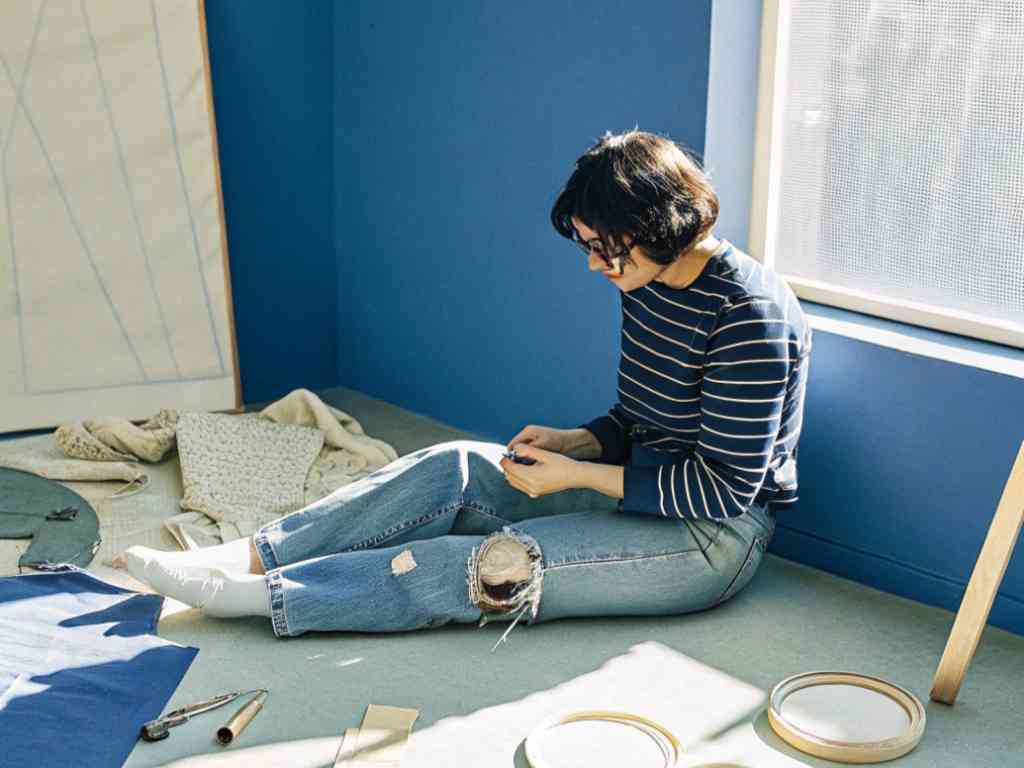A ripped pair of jeans doesn’t mean it’s time to throw them out—especially when no-sew patching can fix them in minutes and add personality to your look.
You can easily patch jeans without sewing by using iron-on patches1, fabric glue2, or fusible web3. These methods restore your denim’s strength and style without needing a sewing machine.
I still remember my favorite high-waisted jeans tearing just before a night out. I had no time—or a sewing machine—but with a floral patch and my iron, they were back in action in under 10 minutes.
Why Patch Jeans Instead of Throwing Them Away?
Fashion today is as much about smart choices as it is about style. Repairing your jeans can actually elevate your wardrobe and values.
Patching helps your jeans last longer while reducing waste. It’s also a way to add character, creativity, and flair to your clothing.
How does patching denim help extend the life of your favorite fashion pieces?
Denim is a durable fabric, and small rips don’t mean it’s the end. A well-placed patch strengthens the area and prevents the tear from growing. It gives your favorite jeans a second life.
Is patching more sustainable and stylish than buying new clothing?
Yes. Repairing is a sustainable habit—it saves money and reduces landfill waste. Plus, visible mending is trending. Patches can make your jeans one-of-a-kind and fashion-forward.
What Tools and Materials Do You Need for No-Sew Jean Repair?
You don’t need much to get started. Most materials can be found at craft stores or online.
For no-sew denim repair, all you need are iron-on patches, fabric glue, scissors, and a hot iron. Optional tools like a pressing cloth and stabilizer help create a smoother finish.
What type of iron-on patches or fabric glue work best for denim?
Look for heavy-duty, washable iron-on patches or fabric glue labeled “permanent” and “flexible.” Brands like HeatnBond and Aleene’s offer options designed for thicker fabrics like denim.
Do you need special fabric scissors, stabilizer, or a pressing cloth?
Sharp fabric scissors ensure clean cuts. A stabilizer keeps lightweight patches from shifting, especially on stretch denim. A pressing cloth protects your jeans from heat damage during patching.
How to Patch Jeans Without Sewing: A Step-by-Step Guide
No-sew patching might sound tricky, but it’s actually fast and beginner-friendly when you follow the right steps.
Use iron-on patches or fusible web for a quick repair. Just cut, position, press, and go. For invisible fixes, fabric glue works well, especially under the tear.
How to use an iron-on patch to fix a hole or tear in jeans?
- Trim any loose threads around the hole.
- Cut your patch slightly larger than the damaged area.
- Place the patch underneath or over the hole.
- Cover with a pressing cloth.
- Press with a hot iron (no steam) for 30–45 seconds.
- Let it cool for a strong bond.
Can you use fabric glue or fusible web for invisible patching?
Yes. Fusible web is great for inside-the-jeans patching. It melts between the patch and denim, holding them together without stitching. Fabric glue works best when applied thinly and pressed firmly for even adhesion.
What Are Creative Patch Ideas That Match Your Style?
No-sew patches aren’t just for fixing—they can be fashion statements. With the right fabric or placement, they elevate your jeans into runway-ready pieces.
Try floral fabrics, printed shapes, or even mix-and-match denim scraps. You can create a custom look while reinforcing the garment.
What stylish patch placements work well for women’s jeans?
- Knee patches: Functional and trendy.
- Back pocket accents: Add a surprise detail.
- Side leg panels: Elongate the look.
- Thigh embroidery patches: Feminine and bold.
Can you add decorative elements like embroidery or printed fabric?
Definitely. If you’re feeling crafty, combine patches with iron-on embellishments or pre-embroidered fabric. Even printed cotton in fun shapes can give your jeans a playful upgrade.
How Long Will a No-Sew Patch Last?
The biggest concern with no-sew repairs is durability. But if done correctly, they can hold up surprisingly well.
A well-applied patch with strong adhesive or heat bonding can last for dozens of wears and washes. Adding reinforcement helps extend its life even more.
Is a glued or ironed-on patch durable for everyday wear?
Yes, especially if you use fabric glue or iron-on materials made for denim. They hold through regular wear. However, intense friction or tight fits may weaken them over time.
How can you reinforce a patch to last through multiple washes?
- Always follow adhesive instructions carefully.
- Let it cool completely after pressing.
- Wash jeans inside out and avoid hot water.
- For added strength, apply fusible web on both patch and denim before ironing.
Conclusion
You don’t need a sewing machine to save your jeans. With a patch and a little heat or glue, you can repair and reinvent them with ease.
-
Explore this link to find high-quality iron-on patches that ensure a durable and stylish fix for your jeans. ↩
-
Discover the effectiveness of fabric glue for no-sew repairs and find the best options available for your projects. ↩
-
Learn about fusible web and its benefits for invisible patching, making your denim repairs seamless and strong. ↩






